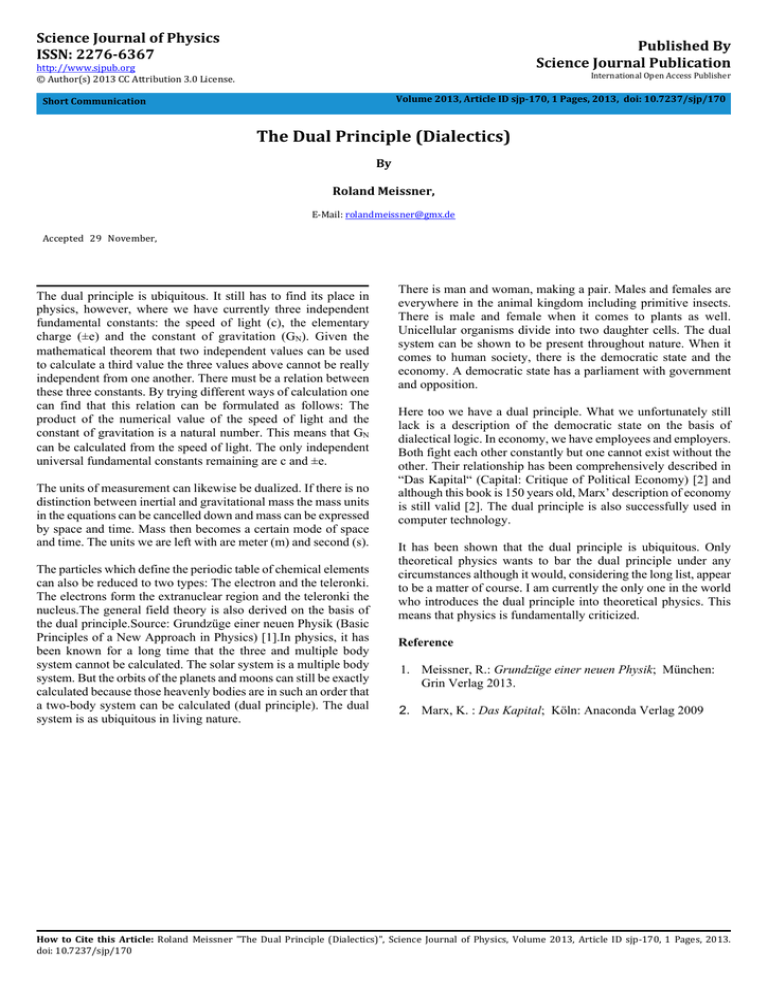The Dual Principle (Dialectics) Science Journal of Physics Published By ISSN: 2276-6367
advertisement

Science Journal of Physics ISSN: 2276-6367 Published By Science Journal Publication http://www.sjpub.org © Author(s) 2013 CC Attribution 3.0 License. International Open Access Publisher Volume 2013, Article ID sjp-170, 1 Pages, 2013, doi: 10.7237/sjp/170 Short Communication The Dual Principle (Dialectics) By Roland Meissner, E-Mail: rolandmeissner@gmx.de Accepted 29 November, The dual principle is ubiquitous. It still has to find its place in physics, however, where we have currently three independent fundamental constants: the speed of light (c), the elementary charge (±e) and the constant of gravitation (GN). Given the mathematical theorem that two independent values can be used to calculate a third value the three values above cannot be really independent from one another. There must be a relation between these three constants. By trying different ways of calculation one can find that this relation can be formulated as follows: The product of the numerical value of the speed of light and the constant of gravitation is a natural number. This means that GN can be calculated from the speed of light. The only independent universal fundamental constants remaining are c and ±e. The units of measurement can likewise be dualized. If there is no distinction between inertial and gravitational mass the mass units in the equations can be cancelled down and mass can be expressed by space and time. Mass then becomes a certain mode of space and time. The units we are left with are meter (m) and second (s). The particles which define the periodic table of chemical elements can also be reduced to two types: The electron and the teleronki. The electrons form the extranuclear region and the teleronki the nucleus.The general field theory is also derived on the basis of the dual principle.Source: Grundzüge einer neuen Physik (Basic Principles of a New Approach in Physics) [1].In physics, it has been known for a long time that the three and multiple body system cannot be calculated. The solar system is a multiple body system. But the orbits of the planets and moons can still be exactly calculated because those heavenly bodies are in such an order that a two-body system can be calculated (dual principle). The dual system is as ubiquitous in living nature. There is man and woman, making a pair. Males and females are everywhere in the animal kingdom including primitive insects. There is male and female when it comes to plants as well. Unicellular organisms divide into two daughter cells. The dual system can be shown to be present throughout nature. When it comes to human society, there is the democratic state and the economy. A democratic state has a parliament with government and opposition. Here too we have a dual principle. What we unfortunately still lack is a description of the democratic state on the basis of dialectical logic. In economy, we have employees and employers. Both fight each other constantly but one cannot exist without the other. Their relationship has been comprehensively described in “Das Kapital“ (Capital: Critique of Political Economy) [2] and although this book is 150 years old, Marx’ description of economy is still valid [2]. The dual principle is also successfully used in computer technology. It has been shown that the dual principle is ubiquitous. Only theoretical physics wants to bar the dual principle under any circumstances although it would, considering the long list, appear to be a matter of course. I am currently the only one in the world who introduces the dual principle into theoretical physics. This means that physics is fundamentally criticized. Reference 1. Meissner, R.: Grundzüge einer neuen Physik; München: Grin Verlag 2013. 2. Marx, K. : Das Kapital; Köln: Anaconda Verlag 2009 How to Cite this Article: Roland Meissner "The Dual Principle (Dialectics)", Science Journal of Physics, Volume 2013, Article ID sjp-170, 1 Pages, 2013. doi: 10.7237/sjp/170






